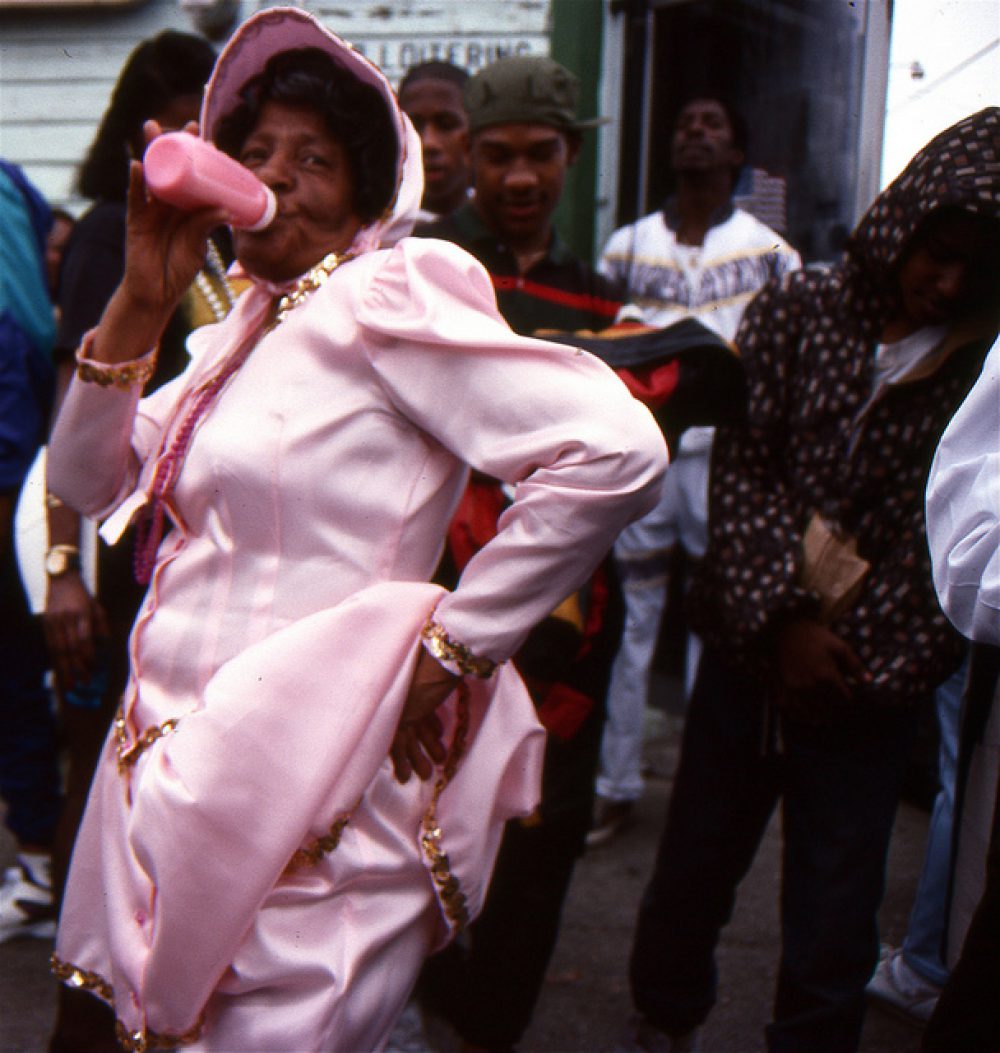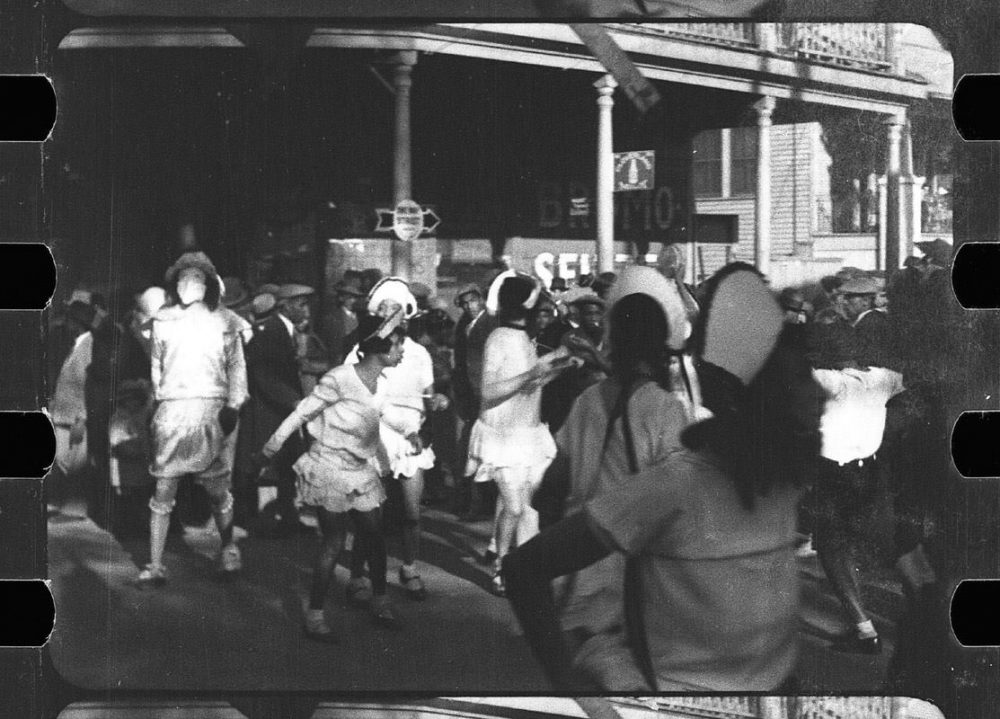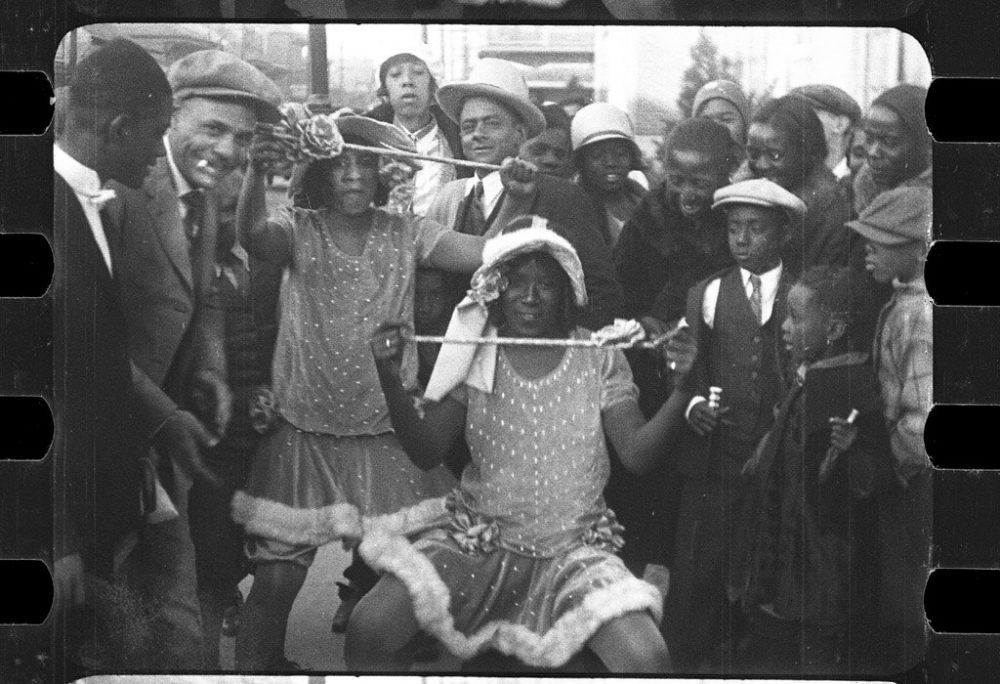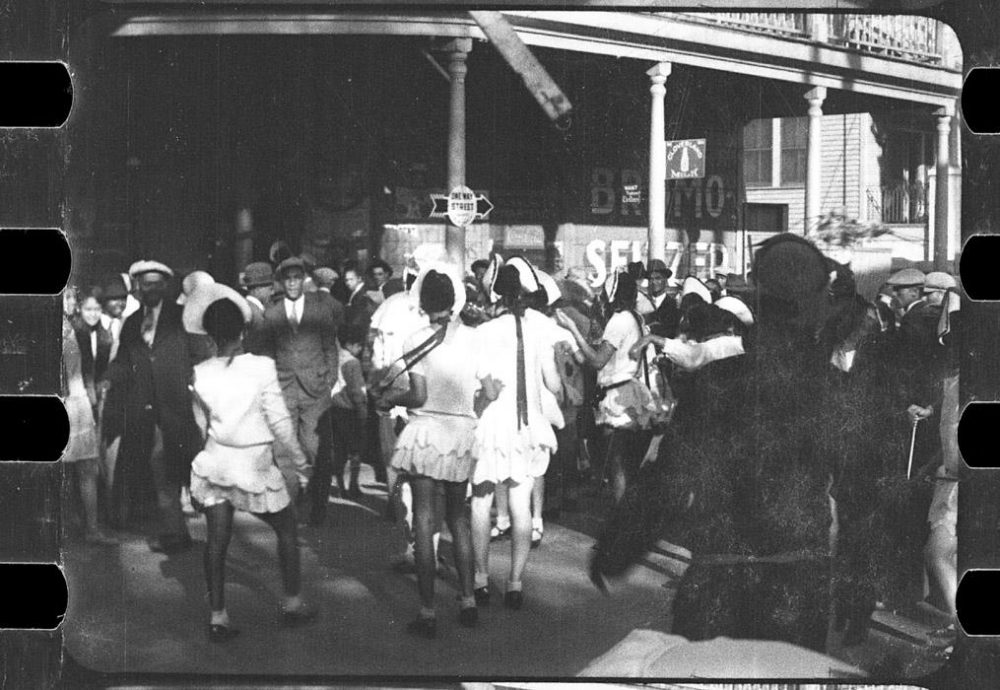Come Get Me: An Interview with Kim Vaz-Deville
Pelican Bomb’s Executive Director Cameron Shaw talks with scholar Kim Vaz-Deville about the history of the Baby Dolls, a unique and distinctly female masking tradition in New Orleans.

Alma “Mama Goo” Borden in New Orleans’ Tremé neighborhood, Mardi Gras, 1992. Photo by Ed Newman.
Editor's Note
Much has been written about the male-dominated masking traditions of New Orleans. Less has been penned, even known, about the Million Dollar Baby Dolls, a tradition that emerged out of the dancehalls and brothels of Black Storyville. Working women, likely prostitutes, first stepped out in short dresses and bonnets imitating young girls on Mardi Gras Day in 1912—singing, dancing, and showing off their hard-earned money. Though the tradition has waxed and waned over the years, today, you can find nurses, teachers, all manner of women, young and old, masking as Baby Dolls on Mardi Gras Day, Super Sunday, or in the Satchmo Salute second-line parade. Part of our exploration of parties as sites of identity, resistance, and desire, Pelican Bomb’s Executive Director Cameron Shaw sat down with scholar Kim Vaz-Deville to discuss her book on the Baby Dolls, politics, entrepreneurship, and shaking it in the streets.
Cameron Shaw: When did you first learn about the Baby Dolls?
Kim Vaz-Deville: I started researching the Baby Dolls towards the beginning of 2010. I was working on a larger book-length project about how marginalized people in New Orleans have historically used the public sphere and public space to instill in each other different values and celebrate themselves. Even though I grew up here, I had never heard of the Baby Dolls. The height of the Baby Dolls was the 1930s up until the ’50s, when the tradition started dying out. There was a minor resurgence in the ’80s, but not enough to impact younger generations and their awareness.
CS: Was there much historical documentation?
KVD: In my research on Mardi Gras, there was only one source that was quoted over and over again and it was Robert Tallant and Lyle Saxon’s Gumbo Ya-Ya. That’s a troubling book on many levels for the way it perpetuates stereotypes. Many of the earliest Baby Dolls were prostitutes, and the description of these women lacked humanity. They may not have lived their lives according to the prevailing middle-class value system; nevertheless, they had a value system. Because I’m a Women’s Studies scholar, I wanted to put their lives in context.
CS: The research in Gumbo Ya-Ya dates to the WPA era....
KVD: Exactly. Beyond that limited and outdated viewpoint, there was no further scholarship on the topic.
CS: So you began talking to people in the present as a way of working backwards?
KVD: I read an article about the post-Katrina resurgence of the Baby Dolls by Millisia White. When I learned she was hosting a fundraiser for her dance company, the New Orleans Society of Dance, I went and met some of the women who mask with her as Baby Dolls. I suggested that I could approach Louisiana Cultural Vistas magazine to see if they were open to an article about the tradition. She and I interviewed a lot of people who were currently masking.
CS: Louisiana Cultural Vistas published the article. And many of the interviews you conducted made it into your 2013 book, The “Baby Dolls”: Breaking the Race and Gender Barriers of the New Orleans Mardi Gras Tradition.
KDV: When you talk to people—especially people in their 60s and 70s who have memories that go back—each of them has a specific vision of what a Baby Doll is. That memory represents for them the truth of the phenomenon. I have since learned that this tradition is one that was popular and visible for the very elderly in our community when they were young. The oldest living Baby Doll masker I have met is Thelma Labat who is 108 years old.

Still from footage of the Baby Dolls in New Orleans, c. 1928 - 1931. Courtesy Story Sloane’s Gallery, Houston.
CS: Your book begins with 1912, when the Baby Dolls likely began, and ends with the present day, but it’s by no means chronological. At the same time, it breaks down certain themes, but they are neither strict nor linear. They weave in and out, which reflects what you’re telling me about the way the history came to you from individual people with different memories of it.
KVD: What I love about the Baby Doll tradition is that it’s completely postmodern. You can’t pin it down. The only thing you can pin down is that on Mardi Gras Day there were women (and even some men) who were going to hit the streets in short skirts and bloomers or “drawers” as they may have been more popularly called in earlier times.
CS: How does a Baby Doll dress?
KVD: The costumes changed with the times. The early Baby Dolls did not have pacifiers and suckers and other childlike things that Baby Dolls in the ’50s might have had. Early Baby Dolls had whips, which I understand was a common prop for maskers. Women were not supposed to be on the streets in costumes in the early 1900s, so, if you had your walking stick or your whip, you could protect yourself if you were threatened. They were careful with how they looked, and they dressed to their taste and style and were proud of themselves.
The early Baby Dolls were very streetwise women who displayed the money they made as a statement of their independence. The idea of making money and showing money is still such a theme among Social Aid and Pleasure groups in New Orleans. There’s a Social Aid and Pleasure Club called the Money Wasters. You hear people calling themselves the Diamond Divas. Having so much money that you can just throw it away means you live the good life. This idea is still something that’s very close to the heart of working-class people. The emphasis is on personhood. How you look is exceptionally important and is always a part of the performance. Later generations had pacifiers, bottles, little baskets, or little purses. Symbols got added on and none were removed.
CS: You’ve mentioned the Baby Dolls’ values, and it sounds like a key value historically was independence. Can you talk about how the Baby Dolls enacted this performance of independence and how that translated into true independence given their limited options?
KVD: It is intimately related to notions of respectability. To be considered a lady in the early part of the century, you had to maintain the appearance of purity. That meant you had to have somebody sheltering and supporting you. Those were impossible conditions for most black women. Black women were in the workforce, which meant domestic work—going into people’s homes and restaurants. They became sexually vulnerable and often sexual prey.

Still from footage of the Baby Dolls in New Orleans, c. 1928 - 1931. Courtesy Story Sloane’s Gallery, Houston.
CS: In your book, there are many mentions of the Baby Dolls’ blonde curls, which must have been wigs, and sometimes white face powder. Were those aesthetic choices meant to throw the importance of virginity and the conditions of whiteness in a man’s face?
KVD: They were making fun of white prostitutes and notions about women as children, dependent but desirable. It was a way of saying: “You want a virgin? Come get me.” For a man to have a girl who was innocent—a girl who would never question his sexual ability, a girl for whom he could be the first—was a real fantasy. So the Baby Dolls played with that fantasy and said, “We can be that for you.”
I want to return to the idea of independence: These women had to take care of themselves and often contribute to their families, so a lot of them rotated in and out of sex work. I interviewed one man in the book, Andrew, who grew up in the Tremé. He talked about his mother doing all kinds of jobs—cooking, sewing, working at a factory—but also being a Baby Doll. This role wasn’t reserved just for Mardi Gras in the Jazz Age. These women would meet men at the ships, maybe dance with them, have a good time, and come back with enough money to take care of their families. So entertaining men became another way that some women earned extra money.
And as I mentioned earlier, the whole idea of respectability, which included being sexually chaste, was rarely available to them. They were thrown to their own devices to survive, but they turned it into a way they could be celebrated. They wanted to be known as beautiful, sexy, and desirable. Through sex work they could say, “People really want me. They pay for my company. They pay to keep me up.” Middle-class and wealthy white women were being pampered in that style, so the Baby Dolls were aspiring to that at the same time that they knew they had to be independent. They weren’t deluded that someone was going to take care of them. There was no safety net.
CS: It’s a complicated dynamic and one that continues to play out today in the presentation and consumption of black women’s beauty and sexuality. There is power in making yourself the most desired sexual object when mainstream beauty standards are framed by whiteness. I’m thinking, for example, about the rise of video vixens, who have now been eclipsed in popular culture by Instagram models. In your book, you talk about the Baby Doll as entrepreneur and self-marketer in the role of club promoter, especially in the 1920s and ’30s. It’s an interesting precursor to how we think about self-presentation now through social media—like a proto-Cardi B. The Baby Dolls understood long ago that by making yourself a brand, you could sell anything—jazz music, sexuality, whatever it was.
Though she abandoned the overt sexuality, Antoinette K-Doe carried on this tradition of the Baby Doll as entrepreneur up until her death in 2009.
KVD: Antoinette K-Doe took that aspect—the self-promotion—of the early Baby Dolls to heart and was very successful at it, so much so that she became synonymous with Baby Dolls in the years following Hurricane Katrina. Combining it with the mannequin of Ernie K-Doe she made after he died, she created a spectacle because she needed to get business into the Mother-in-Law Lounge. She wanted to keep the celebrity going, but she also offered people a place to come and drink—and heal.
CS: I think that is something that people living outside these cultural traditions easily forget. Social performance in its various forms among black New Orleanians was not and is not empty spectacle, but rather is rooted in a need to heal and share healing amongst neighbors and communities.
KVD: The expressive arts are all about being seen because these performative traditions come from a group of people who were historically refused visibility. The best thing for segregated society was if they were totally invisible. So being seen—using fans, feathers, sequins, beads to embellish clothing—became an important statement.

Still from footage of the Baby Dolls in New Orleans, c. 1928 - 1931. Courtesy Story Sloane’s Gallery, Houston.
CS: In its early history, there were more connections between the aesthetics of Baby Dolls and the maskers’ life choices. Today, for those who carry on the tradition, this is simply imaginative play—finding the fun when the day-to-day realities of life can be anything but.
KVD: People come to New Orleans and they want to have a good time, but the black people who are making the culture that’s being promoted often have difficult lives. They’re making minimum wage. They’re dependent on service positions. Their civil liberties can be eroded very easily if they get into some kind of tussle with a neighbor or a police officer. So Mardi Gras is a time of escape from the daily realities, and people need to understand that. People from outside come down and they just want to consume this culture, and I think we have to be very careful about perpetuating the “happy darkie” stereotype, which can so easily be done the way New Orleans promotes itself through these iconic images of the second line or even Southern hospitality via service by black staff. I saw a commercial for a waste management company and it was of a black man serving a whole group of white people in a familiar restaurant, so those images are still prevalent. They perpetuate stereotypes and feed into that expectation that black people are always happy, always ready to serve, always ready to perform, so nobody has to pay attention to the social conditions of their lives. Understanding black life—not from the position of how it functions in the entertainment world, in the pleasure world of white people, but who black people are and what they have to struggle with—is the real message of my book.
CS: Can you talk about the term “low-frequency politics”?
KVD: That is an interesting term that I came upon in my research. Because when you reverse everything that is culturally acceptable, which the early Baby Dolls did, you have politics. For example, a woman wasn’t supposed to smoke; she wasn’t supposed to wear a short skirt; she wasn’t supposed to dance in an erotic way. These behaviors are reversals of normative behavior for women of that time. Suddenly you’re exposing social norms and that’s what makes it so arresting for the viewer. It’s like none of these things are supposed to be happening, but they’re happening. So they tell us about what women can’t do. That’s politics right there, when the Baby Dolls were in no way political. They simply embraced the idea of doing something with their bodies that nobody else could control. Many people continue to be ambivalent about the Baby Dolls because they have their origin in sexuality and women expressing their own sexuality freely and visibly on the street.
CS: Hindsight is 20/20. We’ve seen the trajectory of feminism; we’ve seen the trajectory of black identity politics. So it’s hard to look back at those gestures and see them as anything other than political because they were so radical, but that doesn’t mean that’s the place from which they were coming.
KVD: They probably were pretty conscious about creating those transgressions, but it was to have people talk about them, not to affect political change. They wanted to draw attention and be known.

Alma “Mama Goo” Borden in New Orleans’ Tremé neighborhood, Mardi Gras, 1992. Photo by Ed Newman.
CS: The transgressions around race and gender are clear. But there’s this other element that you mentioned at the beginning of our conversation: age. The Baby Dolls are not young women.
KVD: No, they’re not.
CS: There’s something interesting and powerful about seeing an 80-year-old woman dressed as a Baby Doll. Can you talk about how age factors into the tradition?
KVD: You have to be old enough to where you have your own money to take care of yourself. You have to be self-possessed enough to get out there in a costume. You have to be able to weather that ambiguity and judgment from other people. And you have to have a community context in which to do it. You don’t really get that in your 20s! (laughs) But I think the reason that the resurgence started among older women after Katrina is because they remember the tradition. They’re paying homage to their relatives by doing it, and they know that in New Orleans you are never too old to mask.
CS: Your book includes detailed micro-histories throughout. That reflects a certain methodology towards history and historical narrative. Can you talk about that choice to go so deep into the individual stories of people who may not otherwise be part of our history books or even our thinking about what warrants inclusion in a history book?
KVD: I felt the power as I was putting together the index of the book because I was writing down names of people like Beatrice Hill and Leola Tate. These were women who have been otherwise erased from history because they were black; they were prostitutes; they were poor; they were probably partially literate. To be able to put them in an index was a way to mark them and give them a space. I felt that was one of the most important things I did—to piece together their lives from the fragments that were available.
CS: You went into such great detail, not only who they were, but who their grandmothers were and what streets they might have lived on. There’s a real insistence that these details are important, that these people are important, that we should even know the streets on which they lived because that’s part of their story.
KVD: The street was not just a street. The street was where so much happened. People would cross to each other’s houses to borrow food, to comfort each other when there was a death, and to celebrate a baptism, a confirmation, a birthday. They couldn't go a whole lot of places, so the street was where life took place and connections happened.



